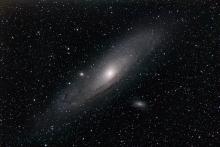Listen to today's episode of StarDate on the web the same day it airs in high-quality streaming audio without any extra ads or announcements. Choose a $8 one-month pass, or listen every day for a year for just $30.
You are here
Close Neighbor
Astronomical distances can be mind boggling. Our closest neighbor, the Moon, is a quarter of a million miles away — equal to about 10 trips around Earth’s equator. The closest planet, Venus, is always at least a hundred times farther. And the closest neighboring star, Proxima Centauri, is about a million times farther still.
Yet even that is just a hop compared to the distance to the most remote object that’s easily visible to the unaided eye. The Andromeda Galaxy is more than half a million times farther than Proxima Centauri — two-and-a-half million light-years.
Right now, the galaxy stands in the east-northeast, about half-way up the sky, at nightfall. It looks like a faint patch of light about as wide as the Moon. Binoculars bring it into better view.
Like our home galaxy, the Milky Way, Andromeda is a wide, flat disk. The visible part of the disk spans more than a hundred thousand light-years. But powerful telescopes reveal that stars taper off into space well beyond that, making the disk twice as wide as the Milky Way’s.
We see the galaxy almost edge-on, which raises another mind-boggling detail about astronomical distances. It takes the light from the far edge of the disk much longer to reach our eyes than the light from the near edge. So there’s no way to see the Andromeda Galaxy at a single point in time. Instead, we see different parts of it as they looked over a span of almost a hundred thousand years.
Script by Damond Benningfield





